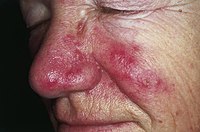
Photo from wikipedia
Background Our previous study found that a long-term diet incorporating spicy foods can reduce the human basal pain threshold. Capsaicin is the pungent ingredient in chili peppers. Transient receptor potential… Click to show full abstract
Background Our previous study found that a long-term diet incorporating spicy foods can reduce the human basal pain threshold. Capsaicin is the pungent ingredient in chili peppers. Transient receptor potential vanilloid type1 is the capsaicin receptor expressed in the oral cavity and is the primary sensory neuron of the “pain” pathway. Few studies have examined the association between long-term spicy diet and chronic postsurgical pain (CPSP). Women who underwent elective cesarean section (eCS) have consistent characteristics of CPSP. This study aimed to investigate the relationship between a long-term spicy diet and the incidence of CPSP after eCS. Methods Participants were divided into a low frequency group (LF, numerical rating scale (NRS)<5) for spicy food consumption and a high frequency group (HF, NRS≥5) by receiver operator characteristic analysis. The primary outcome was the incidence of CPSP three months after eCS. Propensity score matching (PSM) analysis was performed between the two frequency groups. Stepwise logistic regression analysis was then performed. Results Of the 1029 enrolled patients, data from 982 were analyzed 3 months after eCS. After PSM, the incidence of CPSP in the HF group (30.1% [108/359]) was higher than that in the LF group (19.8% [71/359]; P = 0.001). Compared with the LF group, the risk of CPSP in the HF group increased 1.61 times by 3 months (95% CI 1.18–2.20, P = 0.003). PSM results found that 1 year, the incidence of CPSP in the HF group (15.2% [56/369]) was higher than that in the LF group (8.1% [30/369], P = 0.003). Conclusion With an NRS≥5 as a boundary, women who consumed spicy food ≥ 2 days/week were more likely to have CPSP than those who consumed spicy food < 2 days/week.
Journal Title: Journal of Pain Research
Year Published: 2022
Link to full text (if available)
Share on Social Media: Sign Up to like & get
recommendations!